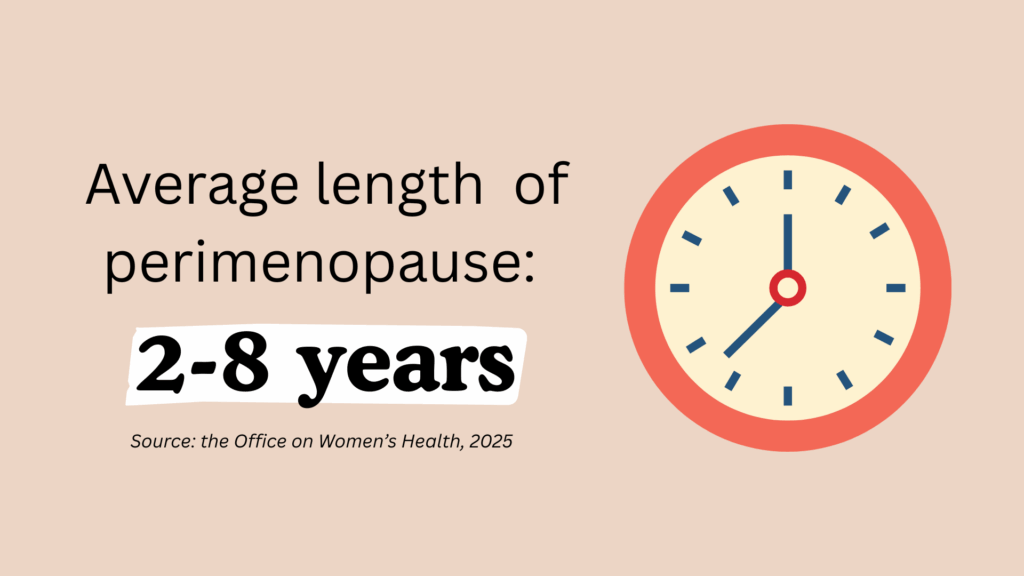A Season of Transition: Three Things You Need to Know About Perimenopause

Whether it’s the reappearance of pumpkin spice on the menu, breaking out your favorite sweaters, or recognizing Menopause Awareness Month, October is all about celebrating the spirit of transition. One of the most significant shifts in someone’s reproductive life is perimenopause – let’s demystify it together.
What is perimenopause?
Perimenopause is your body’s natural transition leading up to menopause. Because everyone’s body is different, it’s a stage that can start at different ages and last for different amounts of time1. However, on average, perimenopause often starts around someone’s mid-to-late forties2. It usually lasts between 2-8 years2.

Menopause, which marks the end of this stage, is defined as when your periods stop permanently and you can no longer get pregnant. You are officially considered menopausal after 12 months without a period2.
Think of how summer transitions into fall; it happens gradually, not overnight. Sometimes, it can feel like a beautiful, if not subtle display of new colors and a welcome relief from a lot of activity. Other times, it can feel like you experience all four seasons in one day, fluctuating temperatures and all. Menopause, much like winter, marks the culmination of this transition (and is a new season in its own right).
What causes perimenopause?
The body enters perimenopause when the ovaries start to transition more into a state of rest. As ovaries age, they start to produce less follicles (the small, fluid-filled sacs that contain developing eggs). This leads the ovaries to start producing less of certain hormones like estrogen and progesterone1. Changes in how we feel, both subtle and profound, start to appear as a result.
What are three things should everyone know about perimenopause?
With how important the menopausal transition is, more research is needed to better understand how it affects people throughout their lives. Studies like the Apple Women’s Health Study are currently working to close that gap and are studying menopause specifically.
Here are three things everyone should know about this stage:
- Perimenopause symptoms can be diverse and surprising.
The experience of perimenopause is highly individual. You may notice things like hot flashes, changes to your periods, vaginal dryness, sleep issues, mood swings, or changes to your interest in (or ability to enjoy) sexual activity.
Other changes are things you may not always notice, but they still matter. For example, some people experience higher cholesterol levels that can raise their risk for heart problems2.
- Our environment and lifestyle can affect how we experience menopause.
Common chemicals in our environments can influence our hormone levels and change how we experience menopause3. These chemicals can be found in makeup products and more. Using them frequently over time may be linked with different reproductive problems across the whole lifespan4. More research is needed for scientists to better confirm more precise risks of exposure.
- Monitoring your menstrual cycle matters.
Understanding what is normal for you and your body can make a big difference when it comes to understanding changes down the line. For example, while changes to bleeding patterns (including heavier bleeding) is normal during perimenopause, it can sometimes be a symptom of a health problem. Monitoring your menstrual cycle can provide good information for your own self-knowledge and help improve conversations with your doctor. Learn more here.
Knowledge is always power. As October reminds us of all things change, let’s embrace understanding our own natural transitions with compassion, curiosity, and science on our side.
References
1: A. K. Wegrzynowicz, A. C. Walls, M. Godfrey and A. Beckley, “Insights into Perimenopause: A Survey of Perceptions, Opinions on Treatment, and Potential Approaches,” Women (Basel, Switzerland), vol. 5, no. 1, 2025.
2: Office on Women’s Health, “Menopause basics,” 17 March 2025. [Online]. Available: https://womenshealth.gov/menopause/menopause-basics. [Accessed 24 September 2025].
3: R. S. Babadi, P. L. Williams, E. V. Preston, Z. Li, R. L. Smith, R. S. Strakovsky, S. Mahalingaiah, R. Hauser, J. A. Flaws and T. James-Todd, “Phthalates and sex steroid hormones across the perimenopausal period: A longitudinal analysis of the Midlife Women’s Health Study,” Environ Int, 2024.
4: E. Chow and S. Mahalingaiah, “Cosmetics use and age at menopause: Is there a connection?,” Fertil Steril, vol. 106, no. 4, p. 978–990, 2016.
5: The American College of Obstetricians and Gynecologists, “Perimenopausal Bleeding and Bleeding After Menopause,” October 2020. [Online]. Available: https://www.acog.org/womens-health/faqs/perimenopausal-bleeding-and-bleeding-after-menopause. [Accessed 1 October 2025].


